Worms are slow, but they still make great pets...
In my ongoing theme of things that are 'dirty', this article is about composting with worms, the photos below include graphic images of dirt and a close-up of a worm... consider yourself forewarned.
Why worm composting - worm-bin set up - first 'harvest' - Andrea's Eco-Challenge - worm links - worm biology
This past Saturday March 30th we celebrated 'Earth Hour', an environmental awareness raising event. We turned off all the lights, and I cooked dinner by candle light and contemplated my 'carbon footprint'. Racing a vintage two-stroke is not a very environmentally friendly hobby, and I'm the owner of more than the usual number of internal combustion motors, so I probably use up considerably more than my share of personal carbon credits. By looking for other ways to reduce my impact on the planet, I can enjoy my race bike without too much guilt over the environmental consequences of the occasional puff of two-stroke smoke.
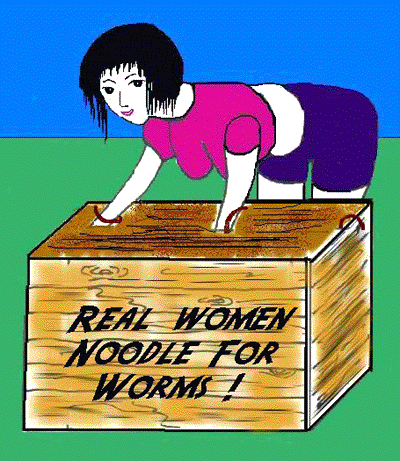 So that's why I got a worm farm. I'm sure some of my racing friends are just waiting to tell me I got a worm farm 'cause slow pets make me feel fast. Worms are slow, but it's their simple efficiency that fascinates me. Worms don't have eyes or ears, but they can sense light (what we call seeing when we do it) and they can sense vibration (with our specialized ear organs we call that hearing). Worms have five hearts, which strikes me as very sensible; the heart is a smart choice if you're going to have redundant systems. We'd live longer with two never mind five.
So that's why I got a worm farm. I'm sure some of my racing friends are just waiting to tell me I got a worm farm 'cause slow pets make me feel fast. Worms are slow, but it's their simple efficiency that fascinates me. Worms don't have eyes or ears, but they can sense light (what we call seeing when we do it) and they can sense vibration (with our specialized ear organs we call that hearing). Worms have five hearts, which strikes me as very sensible; the heart is a smart choice if you're going to have redundant systems. We'd live longer with two never mind five.
Now my new worms aren't just any worms, they are a cousin of the earthworm, colloquially known as a Red Wriggler - Eisenia foetida is their Latin name. They forage closer to the surface than earthworms, and they eat 'fresher' compost - earthworms prefer more through decayed material, and forage deeper.
Researching vermicomposting lead me through a wide range of resources, and eventually discovered a great Canadian company, here in Ontario, that offers valuable worm composting information, kits and worms too. Cathy responded personally to my e-mailed questions, and the kit/worm shipping was very prompt too. Visit Cathy's Crawly Composters: www.cathyscomposters.com for more information. My kit arrived 'just add water' with well written instructions and lots of worm-keeping information.
I'm not sure how my worms felt about their journey through the postal system, but when I set them loose on top of their bedding, they dug down into it away from the light, and presumably settled in happily to their new home.
Andrea's Worm HabitatThis is my worm composting bin from Cathy's Crawly Composters. I considered making my own worm bin, but I wanted to make sure I had a safe and healthy habitat for my worms, so I decided to buy a pre-made bin, and since I needed to order worms anyway, it seemed easiest; and it was. www.cathyscomposters.com
|
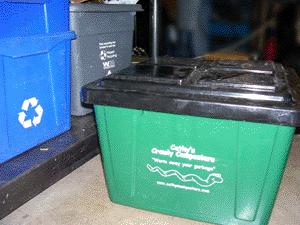
|
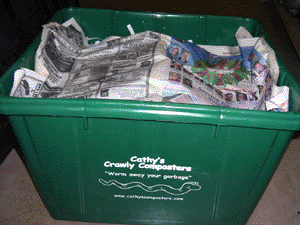
|
Under the lid I keep a few sheets of newspaper, this helps keep the moisture in, and fruit flies out. Worms produce heat and moisture as byproducts of their process, but they also live naturally in a moist environment, so managing moisture and airflow is important. This bin is ventilated well, and so far it's been easy to maintain the moisture without leakage, and the worms don't get out.
|
|
Under the sheets of newspaper you can see the worm 'bedding' of wet shredded paper. This is what the worms live in while they work, and also what they consume. They apparently eat about equal quantities of bedding and compost each day. Shredding your documents and then running them through the digestive system of a worm should make for pretty secure document disposal I would think.
|
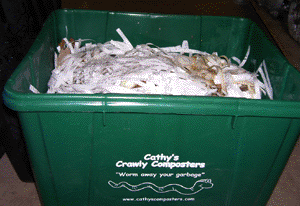
|
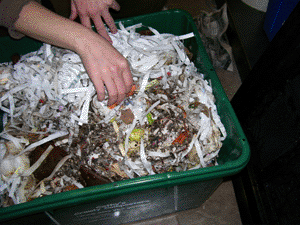
|
When I pull back the top layer of bedding, you can see where I've buried my compost for the worms to eat. Red Wrigglers feed just under the surface, on newly decaying material - they don't want fresh food, but food that is starting to rot - food you don't want anyway. It's so easy to make your pet worms happy.
|
| If you dig deeper and look more closely, you can see the worms at work. They don't like the light, and as soon as you expose them they dig themselves in under the surface. Even with weeks worth of decaying food, the worm bin isn't smelly. If you stick your nose in close, you can detect an aroma of wet earth, coffee grinds and wet paper, but once the lid is on the bin, you don't smell anything. Even after digging around in the bin, my hands don't come out smelly. |
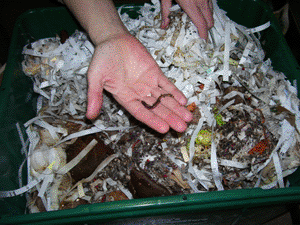
|
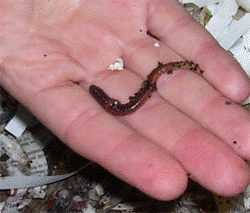
|
My little worm friend here doesn't like to be exposed to the light, and he/she twitched when the flash went off. It's a small but mature worm, you can see her/his clitellum - the thick ring toward the front end - which you wouldn't if he/she were a juvenile worm. We don't really have language suitable for dealing with hermaphroditic species do we? All worms have the equipment of both genders (another useful redundant system) so one can't very well call a worm 'it' - we use that for things without gender, or with indeterminate gender - and when it comes to gender, worms have it all! Our language, however, is not well equipped to cope with the elegant simplicity of a worm of both genders.
|
|
In this photo you see my worm composter set up on a sturdy shelf. Worms are sensitive to vibration so I tried to find them a spot where the wouldn't be joggled about. They don't like light either, but the opaque lid on the worm-kit takes care of that, so I didn't have to worry to much about their comfort in that regard. I keep the bin propped up on wood so air can flow through the drainage and ventilation holes, and a tin-foil drip tray meant for the oven under the bin to catch any moisture dripping out - so far that hasn't been a problem. (More drips out after a few months as the bin composts)
|
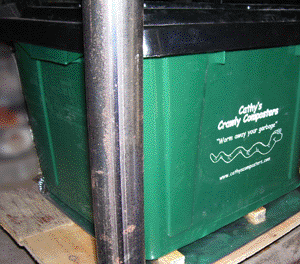
|
|
Even if you don't share my fondness for worms, composting with worms is very efficient and environmentally friendly. I don't garden, and my few house-plants don't need much compost, but my vermicompost is so sought after I have two competing bidders for my first harvest, both avid gardeners. Reducing the waste you ship to municipal composting or into landfill is worth the small extra efforts involved in composing with worms. Worms may seems slow, but they devour compost pretty fast. They contribute more to the household than most pets, and ask very little in return, and mostly things I considered waste anyway. Playing with worms might not sound like your kind of dirty, but now my home is more of an ecosystem, and I find that very satisfying.
| |
- top -
Eco-Challenge to 2-stroke Racers:
How do you give back to the earth? Tree-planting, re-using post-consumer packaging, or making your living space more energy efficient? Tell us how you earn back the carbon-credits you're spending racing a 2-stroke! E-mail girl@dirtygirlmotorracing.com with your environmental story.
The first Worm HarvestWhen your worm-bin has been composting for four to six months, and your worms have eaten most of their bedding, it's time to 'harvest' your bin. I thought it was getting time to harvest my bin, so I stopped feeding my worms for about a week, then I picked a nice sunny day and put a table outside. As it turned out, my bin wasn't really ready to harvest, but I'm glad I did - it was too wet and compacted and I think it was making my worms unhappy. They couldn't get into the wet lower layers to eat and the bin wasn't draining moisture well because the bottom was too compacted.
| |
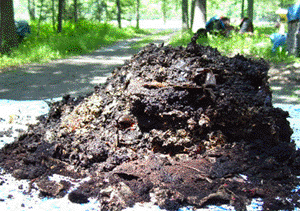
|
By the time I thought I was ready to harvest my worm bin, it was full and heavy too, when dumped out it made a big pile. It was pretty smelly too, but it would have been less odorous if it had not been so wet. I removed the excessively wet and nearly worm-less lay at the top of the pile (bottom of the bin) and this is what remained. You can see it bears little resemblance to the pile of wet shredded paper that I started with.
|
|
The nearly-composted contents of my worm bin, when turned out for sorting. As I took apart the wet pile, I would encounter groups or clusters of worms feeding on something particularly good. Working in the sunlight drives the worms down into the dark, so you can remove the compost and recover your worms for the next bin. Because my worm-bin had become so wet, this process was difficult but necessary.
|
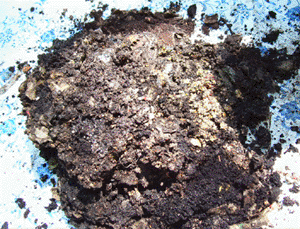
|
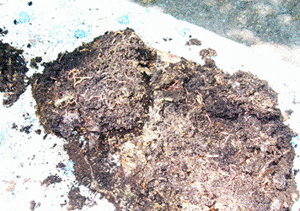
|
Some areas in the worm bin were too wet (and disgusting) to be able to remove all the worms from. If I dried out that compost to give to my gardening friends, it would have killed any worms I left behind. So I put any 'unfinished' compost that might have still had worms in it into the outdoor composter next door. That way the worms I missed in the sort would have a happy life. If the bin had not been so wet, the sorting would not have been so difficult.
|
|
When I found a spot with a lot of worms clustered together around some food they liked, I just put the whole handful into the new bin with fresh bedding. A bit of old compost in the new bin will give the worms something familiar to eat right away. I found some really small worms, they're really cute when they are little and pink :-) and I think I have a healthy and growing population in my bin.
|
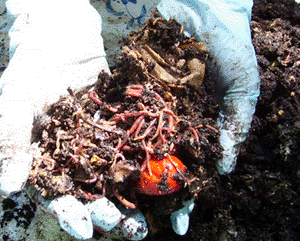
|
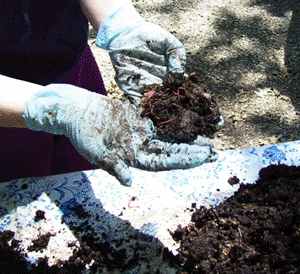
|
Each group of worms shows me a range of sizes and ages, so I think I have a healthy and growing worm population, despite the wet condition of the bin. I'm glad I did the harvest when I did, so my worm population will remain happy and growing. It's neat to see the little tiny worms, only a few centimeters long, but wriggling away and already eating compost. I'm used to seeing earthworms one at a time, and holding a big pile of red wrigglers took a bit of getting used to, but I was more comfortable handling my worms by the time I got through sorting the bin. With a very gentle touch you can pick up even the smallest worm without hurting it.
|
|
The new bin set up with fresh bedding (my shredded confidential documents and junk mail mostly) looks very fresh and clean compared to the very dark organic material that comes out of the bin a few short months later. But I think my worms are happy to be re-bedded into a bin that isn't too wet. I set up this new bin with sticks and leaf material at the very bottom, to provide better natural drainage and aeration, which seems to be working. I've moved my worm-bin outdoors for the summer, I've found them a shadey sheltered spot and propped up the bin for air-flow underneath. I'll bring them back indoors when the nighttime temperatures start to drop. I think I overfed the bin last time, so I'm being more careful about the volume of compost I feed my worms until the population grows a bit. I'm hoping that by the winter I'll have enough worms that I can compost indoors-only for the winter months.
|
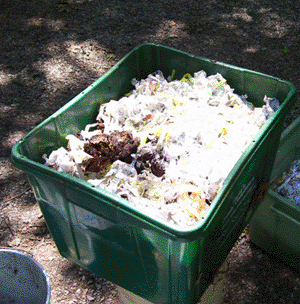
|
- top -
Worm Composting Links:
Canadian Resources to purchase worm bins or wormswww.cathyscomposters.com
www.cathyscomposters.com/instructions
The Author of the most frequently referenced worm-composting book
http://www.wormwoman.com/acatalog/wormwoman.html
Another good resource for do-it-yourself information
www.cityfarmer.org/wormcomp61.html
More Canadian worm composting information
www.peelregion.ca/pw/waste/compost/home/worm.htm
www.peelregion.ca/pw/waste/compost/home/build.htm
Resource for American worm-farm buyers
www.happydranch.com/
A non-profit magazine is dedicated to vermiculture, and composting and recycling with worms
www.wormdigest.org
Starbucks on Coffee composting
www.starbucks.com/aboutus/compost.asp
- top -
More on Worm Biology
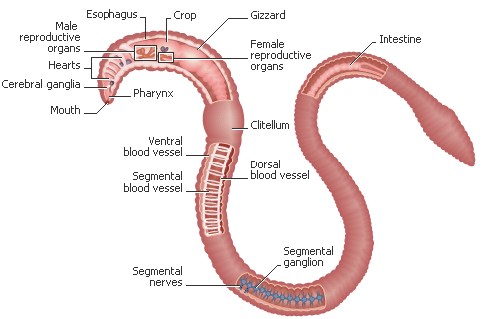
|
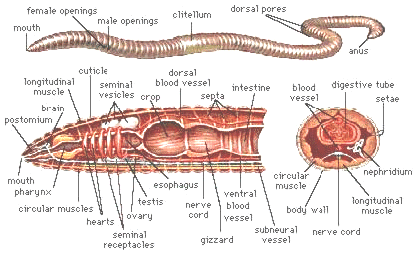
Worm Anatomy images courtesy of www.wormpost.com |
Back to the Articles Page

